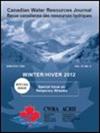安大略省保护当局——结束、演变、间歇还是顿悟?
IF 0.9
4区 环境科学与生态学
Q3 WATER RESOURCES
引用次数: 2
摘要
摘要安大略省保护局(CA)成立于1946年,是安大略省政府和市政府的合作伙伴。最初,他们的目的是应用集水区或分水岭方法来提供服务和计划,通过水和土地管理的综合方法来降低洪水和侵蚀的风险。2021年,共有36个保护机构。我们认为安大略省政府已经或将要启动的与CA相关的关键变更是:(1)相关省级部长将有权在CA内的特定时间内批准特定的开发提案或整个许可证类别,即使CA反对此类开发,因为提案涉及易受洪水或其他相关危害的地区;和(2)如果相关CA的听证委员会拒绝了开发许可证申请人的申请,则他们可以直接向省部长和地方规划上诉法庭(LPAT)提出上诉。本评论描述了历史上被认为对前任和现任省政府“有问题”的关键问题,并分享有关这些问题的信息和见解。结论考虑了这些变化是否代表着CA的结束、进化、间歇(干预期、重新校准或重新聚焦的机会)或顿悟(洞察或理解的时刻),或其某种组合。本文章由计算机程序翻译,如有差异,请以英文原文为准。
Ontario conservation authorities – end, evolve, interlude or epiphany?
Abstract Ontario Conservation Authorities (CAs) were established in 1946 as a partnership between the Ontario provincial government and municipalities. Initially, their purpose was to apply a catchment or watershed approach to provide services and programs to reduce risk from flooding and erosion through an integrated approach to water and land management. In 2021, there are 36 Conservation Authorities. We consider key changes the Ontario Government has initiated or will be initiating related to CAs which are: (1) The relevant provincial Minister will have authority to approve specific development proposals or for an entire class of permits for a specified period of time in areas within CAs, even if the CAs oppose such development because the proposals involve areas vulnerable to flooding or other related hazards; and (2) Applicants for development permits will be able to appeal directly to the Provincial Minister and also the Local Planning Appeal Tribunal (LPAT) if their application is turned down by the Hearing Board of the relevant CA. This commentary describes key issues that have been historically noted as ‘problematic’ for previous and the current Provincial Governments, and shares information and insight on those matters. The conclusion considers whether the changes represent an end, an evolution, an interlude (an intervening period, an opportunity to recalibrate or refocus) or an epiphany (a moment of insight or understanding), or some combination thereof, for the CAs.
求助全文
通过发布文献求助,成功后即可免费获取论文全文。
去求助
来源期刊

Canadian Water Resources Journal
WATER RESOURCES-
CiteScore
2.90
自引率
5.90%
发文量
17
审稿时长
>12 weeks
期刊介绍:
The Canadian Water Resources Journal accepts manuscripts in English or French and publishes abstracts in both official languages. Preference is given to manuscripts focusing on science and policy aspects of Canadian water management. Specifically, manuscripts should stimulate public awareness and understanding of Canada''s water resources, encourage recognition of the high priority of water as a resource, and provide new or increased knowledge on some aspect of Canada''s water.
The Canadian Water Resources Journal was first published in the fall of 1976 and it has grown in stature to be recognized as a quality and important publication in the water resources field.
 求助内容:
求助内容: 应助结果提醒方式:
应助结果提醒方式:


